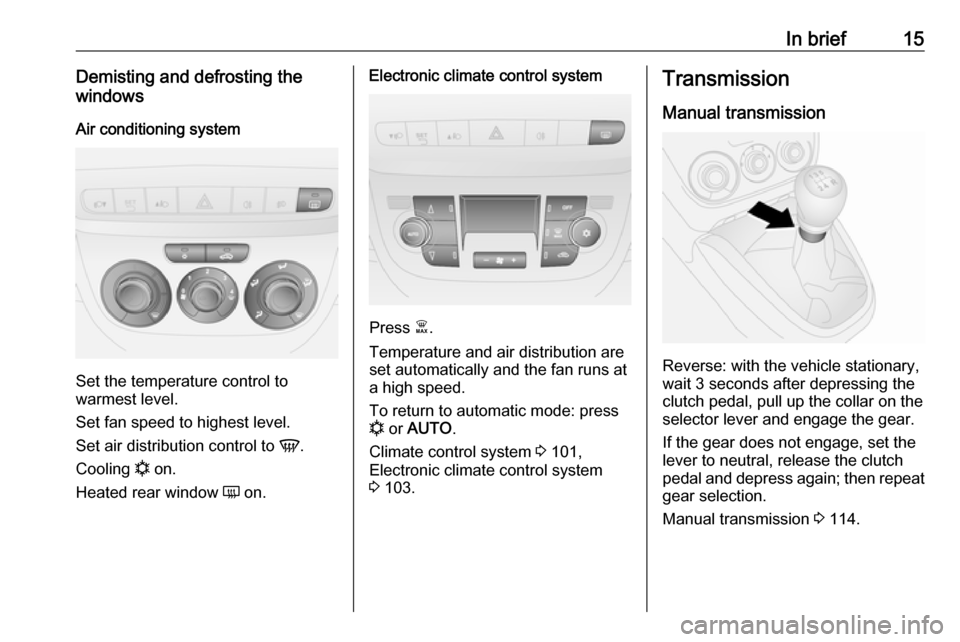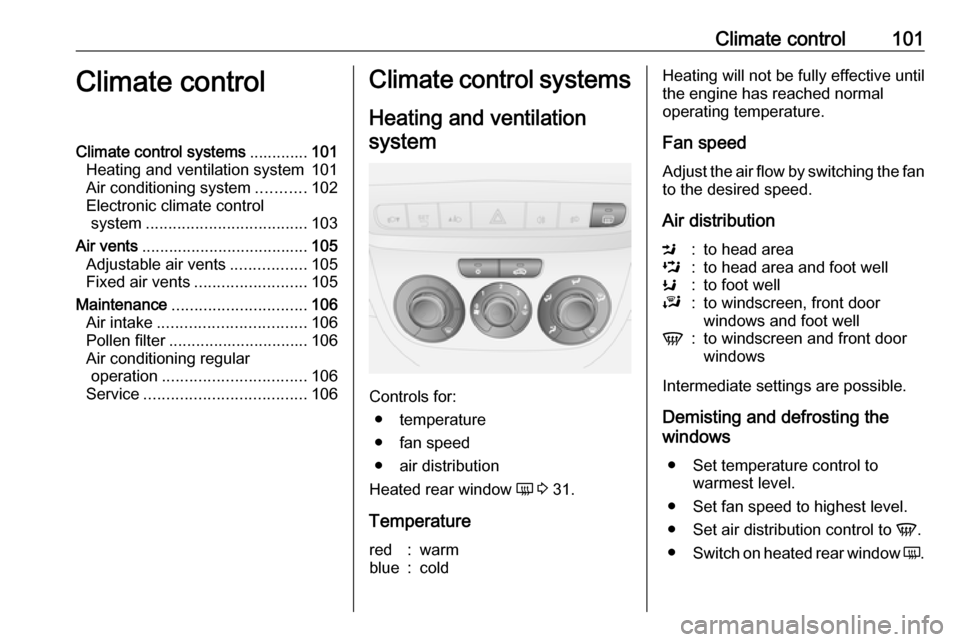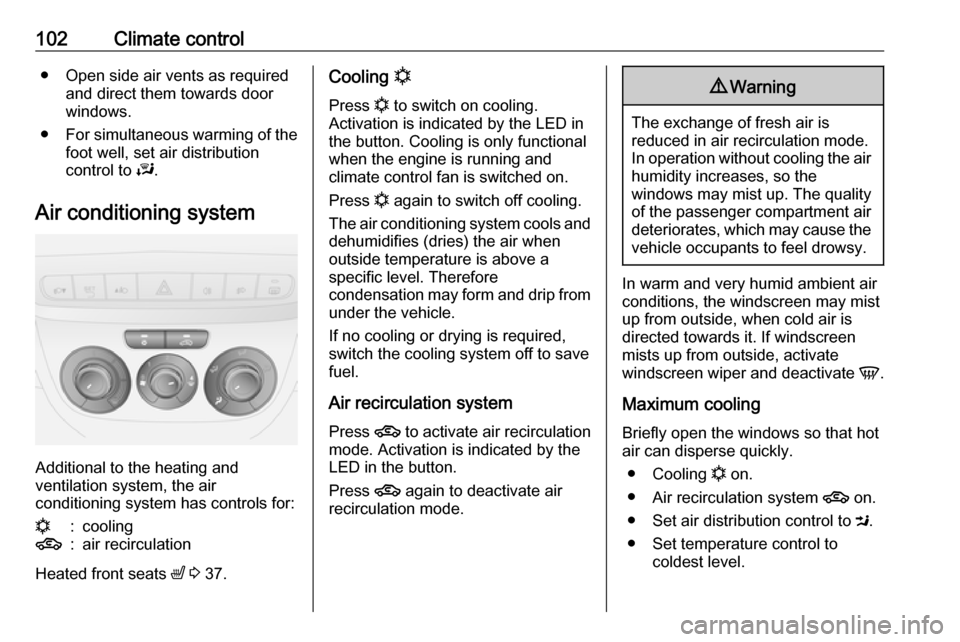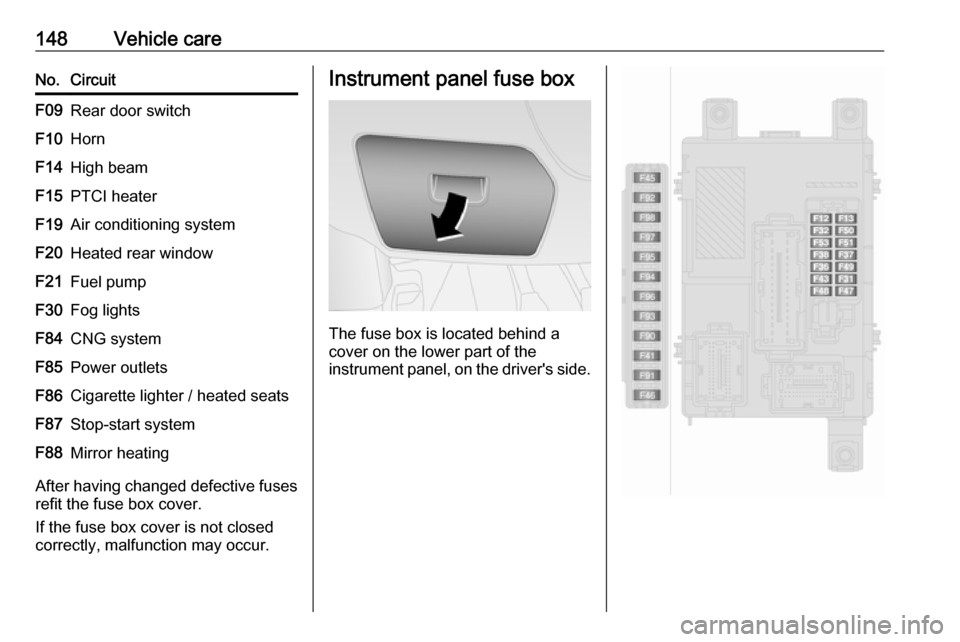air condition VAUXHALL COMBO 2016 Owner's Manual
[x] Cancel search | Manufacturer: VAUXHALL, Model Year: 2016, Model line: COMBO, Model: VAUXHALL COMBO 2016Pages: 189, PDF Size: 4.47 MB
Page 17 of 189

In brief15Demisting and defrosting the
windows
Air conditioning system
Set the temperature control to
warmest level.
Set fan speed to highest level.
Set air distribution control to V.
Cooling n on.
Heated rear window Ü on.
Electronic climate control system
Press Ê.
Temperature and air distribution are
set automatically and the fan runs at
a high speed.
To return to automatic mode: press
n or AUTO .
Climate control system 3 101,
Electronic climate control system 3 103.
Transmission
Manual transmission
Reverse: with the vehicle stationary,
wait 3 seconds after depressing the
clutch pedal, pull up the collar on the
selector lever and engage the gear.
If the gear does not engage, set the
lever to neutral, release the clutch
pedal and depress again; then repeat
gear selection.
Manual transmission 3 114.
Page 103 of 189

Climate control101Climate controlClimate control systems.............101
Heating and ventilation system 101
Air conditioning system ...........102
Electronic climate control system .................................... 103
Air vents ..................................... 105
Adjustable air vents .................105
Fixed air vents ......................... 105
Maintenance .............................. 106
Air intake ................................. 106
Pollen filter ............................... 106
Air conditioning regular operation ................................ 106
Service .................................... 106Climate control systems
Heating and ventilation system
Controls for: ● temperature
● fan speed
● air distribution
Heated rear window Ü 3 31.
Temperature
red:warmblue:coldHeating will not be fully effective until
the engine has reached normal
operating temperature.
Fan speed
Adjust the air flow by switching the fan
to the desired speed.
Air distributionM:to head areaL:to head area and foot wellK:to foot wellJ:to windscreen, front door
windows and foot wellV:to windscreen and front door
windows
Intermediate settings are possible.
Demisting and defrosting the
windows
● Set temperature control to warmest level.
● Set fan speed to highest level.
● Set air distribution control to V.
● Switch on heated rear window Ü.
Page 104 of 189

102Climate control● Open side air vents as requiredand direct them towards door
windows.
● For simultaneous warming of the
foot well, set air distribution
control to J.
Air conditioning system
Additional to the heating and
ventilation system, the air
conditioning system has controls for:
n:cooling4:air recirculation
Heated front seats ß 3 37.
Cooling n
Press n to switch on cooling.
Activation is indicated by the LED in
the button. Cooling is only functional
when the engine is running and
climate control fan is switched on.
Press n again to switch off cooling.
The air conditioning system cools and
dehumidifies (dries) the air when
outside temperature is above a
specific level. Therefore
condensation may form and drip from
under the vehicle.
If no cooling or drying is required,
switch the cooling system off to save
fuel.
Air recirculation system Press 4 to activate air recirculation
mode. Activation is indicated by the
LED in the button.
Press 4 again to deactivate air
recirculation mode.9 Warning
The exchange of fresh air is
reduced in air recirculation mode.
In operation without cooling the air humidity increases, so the
windows may mist up. The quality
of the passenger compartment air
deteriorates, which may cause the vehicle occupants to feel drowsy.
In warm and very humid ambient air
conditions, the windscreen may mist
up from outside, when cold air is
directed towards it. If windscreen
mists up from outside, activate
windscreen wiper and deactivate V.
Maximum cooling Briefly open the windows so that hot
air can disperse quickly.
● Cooling n on.
● Air recirculation system 4 on.
● Set air distribution control to M.
● Set temperature control to coldest level.
Page 106 of 189

104Climate controlclockwise:warmanticlockwise:cold
Heating will not be fully effective until
the engine has reached normal
operating temperature.
When the minimum temperature is
set below 16 ℃, the electronic climate
control system runs at maximum
cooling. LO appears in the display.
If the maximum temperature is set
above 32 ℃, the electronic climate
control system runs at maximum
heating. HI appears in the display.
Fan speed
The selected fan speed is indicated
with bars in the display.
Press ] or < to increase or decrease
the fan speed.
maximum fan
speed:all bars displayedminimum fan
speed:one bar displayed
Press n to deactivate fan.
To return to automatic fan speed: Press AUTO.
Demisting and defrosting the
windows
Press Ê.
Temperature and air distribution are
set automatically and the fan runs at a high speed.
When the vehicle reaches normal
operating temperature the function
remains active for approx. 3 minutes.
To return to automatic mode: press n or AUTO .
Air distribution Press R, S or 6.
LED in buttons illuminate.
Arrows shown in the display indicate
the distribution settings.
Cooling
Press n to switch on cooling.
Activation is indicated by the LED in
the button. Cooling is only functional
when the engine is running and
climate control fan is switched on.
Press n again to switch off cooling.The air conditioning system cools and
dehumidifies (dries) when outside
temperature is above a specific level. Therefore condensation may form
and drip from under the vehicle.
If no cooling or drying is required
press n again to switch the cooling
system off, thus saving fuel.
Manual air recirculation mode Operated by pressing 4.recirculation on:LED in button
illuminated; D
appears in the
displayrecirculation off:LED in button
extinguishes; E
appears in the
display9 Warning
The exchange of fresh air is
reduced in air recirculation mode.
In operation without cooling the air humidity increases, so the
windows may mist up. The quality
Page 107 of 189

Climate control105of the passenger compartment air
deteriorates, which may cause the
vehicle occupants to feel drowsy.
In warm and very humid ambient air
conditions, the windscreen may mist
up from outside, when cold air is
directed towards it. If windscreen
mists up from outside, activate
windscreen wiper and deactivate V.
Air vents
Adjustable air vents
At least one air vent must be open
while cooling is on in order to prevent
the evaporator from icing up due to
lack of air movement.9 Warning
Do not attach any objects to the
slats of the air vents. Risk of
damage and injury in case of an
accident.
Centre air vents
Slide knob to the left to open vent.
Direct the flow of air by swivelling the vent.
Slide knob to the right to close vent.
Side air vents
Slide knob to the left to open vent.
Direct the flow of air by swivelling the vent.
Slide knob to the right to close vent.
Fixed air vents Additional air vents are located
beneath the windscreen and door
windows and in the foot wells.
Page 108 of 189

106Climate controlMaintenanceAir intake
The air intake in front of the
windscreen in the engine
compartment must be kept clear to
allow air intake. Remove any leaves,
dirt or snow.
Pollen filter The pollen filter cleans dust, soot,
pollen and spores from the air
entering the vehicle through the air
intake.
Air conditioning regular
operation
In order to ensure continuously
efficient performance, cooling must
be operated for a few minutes once a
month, irrespective of the weather
and time of year. Operation with
cooling is not possible when outside
temperature is too low.
ServiceFor optimal cooling performance, it is
recommended that the climate control system be checked annually, starting
three years after initial vehicle
registration, including:
● functionality and pressure test
● heating functionality
● leakage check
● check of drive belts
● cleaning of condenser and evaporator drainage
● performance check
Page 115 of 189

Driving and operating113Notice
In the event of an accident with
airbag deployment, the engine is
turned off automatically if the vehicle
comes to a standstill within a certain
time.Engine exhaust9 Danger
Engine exhaust gases contain
poisonous carbon monoxide,
which is colourless and odourless and could be fatal if inhaled.
If exhaust gases enter the interior
of the vehicle, open the windows.
Have the cause of the fault
rectified by a workshop.
Avoid driving with an open load
compartment, otherwise exhaust
gases could enter the vehicle.
Diesel particle filter
The diesel particle filter system filters
harmful soot particles out of the
exhaust gases. The system includes
a self-cleaning function that runs
automatically during driving without
any notification. The filter is cleaned
by periodically burning off the soot
particles at high temperature. This
process takes place automatically
under set driving conditions and may
take up to 25 minutes. Typically it
needs 15 minutes. Autostop is not
available and fuel consumption may
be higher during this period. The
emission of smells and smoke during
this process is normal.
Under certain driving conditions, e.g.
short distances, the system cannot
clean itself automatically.
If the cleaning of the filter is required
and if previous driving conditions did
not enable automatic cleaning, it will
be indicated by control indicator %.
Depending on version, a warning
message may also appear in the
Driver Information Centre (DIC) 3 85.
Control indicator % illuminates when
diesel particle filter is full. Start
cleaning process as soon as possible
to avoid damage to the engine.
Cleaning process To activate cleaning process,
continue driving, keep engine speed
above 2000 rpm. Shift down if
necessary. Diesel particle filter
cleaning is then started.
Page 126 of 189

124Driving and operatingSwitching off
Turn end of lever to the OFF position;
control indicator m extinguishes. The
stored speed is deleted. Switching off
the ignition also deletes the stored
speed.
Parking assist
The parking assist makes parking
easier by measuring the distance between the vehicle and obstacles,
and giving acoustic signals. It is the
driver, however, who bears full
responsibility for the parking
manoeuvre.
The system consists of four ultrasonic parking sensors in the rear bumper.
Control indicator r 3 80.
System operation
The parking assist is turned on
automatically when reverse gear is engaged.
The intervals between the beeps
become shorter as the vehicle gets
closer to the obstacle. When the
distance is less than 30 cm, the beeping is a continuous tone whichstops immediately when the distance
is increased.
Fault
In the event of a fault in the system,
r illuminates and a message is
displayed in the Driver Information
Centre (DIC) 3 85.
The following conditions could affect
the system's performance:
● The ultrasonic sensors are not clean. Keep the bumper free of
mud, dirt, snow, ice and slush.
● The sensors are covered by frost
or ice.● The rear doors / tailgate are open.
● An object was hanging out of the
rear doors / tailgate during the
last drive cycle. Once the object
has been removed, the parking
assist will return to normal
operation.
● An object or cover is attached to the rear of the vehicle.
● The bumper is damaged. Take the vehicle to a workshop to
repair the system.
● Other conditions, such as vibrations from a jackhammer,
are affecting system
performance.
In the event the system still does not
work properly, seek the assistance of
a workshop.
A warning chime is also sounded
briefly if a fault is present when
reverse gear is engaged 3 90.
Notice
The volume of the warning chime
can also be adjusted via the Driver
Information Centre (DIC) 3 85.
Page 150 of 189

148Vehicle careNo.CircuitF09Rear door switchF10HornF14High beamF15PTCI heaterF19Air conditioning systemF20Heated rear windowF21Fuel pumpF30Fog lightsF84CNG systemF85Power outletsF86Cigarette lighter / heated seatsF87Stop-start systemF88Mirror heating
After having changed defective fuses
refit the fuse box cover.
If the fuse box cover is not closed
correctly, malfunction may occur.
Instrument panel fuse box
The fuse box is located behind a
cover on the lower part of the
instrument panel, on the driver's side.
Page 153 of 189

Vehicle care151Tyre pressure
Check the pressure of cold tyres at least every 14 days and before any
long journey. Do not forget the spare
wheel. This also applies to vehicles
with tyre pressure monitoring system.
Unscrew the valve cap.
Tyre pressure 3 179.
The tyre pressure information label
on the door frame (if fitted) indicates the original equipment tyres and the
correspondent tyre pressures.
The tyre pressure data refers to cold
tyres. It applies to summer and winter tyres.
Always inflate the spare tyre to the
pressure specified for full load.
Incorrect tyre pressures will impair
safety, vehicle handling, comfort and
fuel economy and will increase tyre
wear.Tyre pressures differ depending on
various options. For the correct tyre
pressure value, follow the procedure
below:
1. Identify the engine identifier code.
Engine data 3 173.
2. Identify the respective tyre.
The tyre pressure tables show all
possible tyre combinations 3 179.
For the tyres approved for your
vehicle, refer to the EEC Certificate of Conformity provided with your vehicle
or other national registration
documents.
The driver is responsible for correct
adjustment of tyre pressures.9 Warning
If the pressure is too low, this can
result in considerable tyre warm-
up and internal damage, leading to tread separation and even to tyre
blow-out at high speeds.
Tyre pressure monitoring
system
The Tyre Pressure Monitoring
System (TPMS) uses radio and
sensor technology to check tyre
pressure levels.Caution
Tyre pressure monitoring system
warns only about low tyre pressure condition and does not replace
regular tyre maintenance by the
driver.
The TPMS sensors monitor the air pressure in the tyres and transmit tyre
pressure readings to a receiver
located in the vehicle.
All wheels must be equipped with
pressure sensors and the tyres must
have the prescribed pressure.
Tyre pressure chart 3 179.